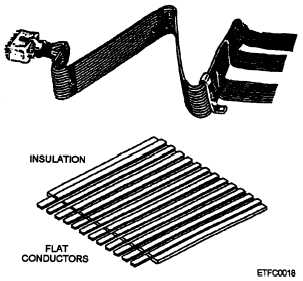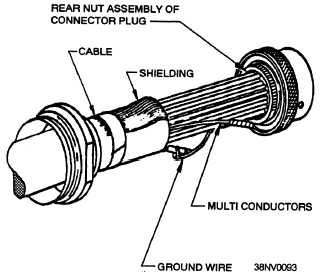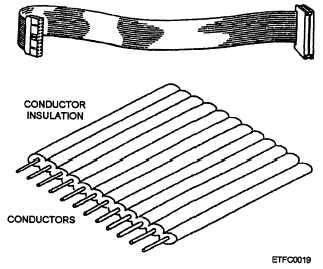computers or digital equipment, and to interconnect
units of the same computer together. We limit our
discussion to I/O cables. The interfacing standards
provide guidelines on the type and maximum cable
length to be used for the I/O data cables. The number
of conductors in each cable varies with type of
computer. A cable can have from 2 to 120 conductors.
The cable is grounded with a signal ground and/or to its
common connector ground. If it has shielding, the
shielding is also grounded to the connector (fig. 2-31).
The cables must also be protected (shielded) from EMI
and RFI. This is accomplished with a solid or braided
covering of nonferrous conductive material, preferably
copper. The cable is completely covered throughout its
length. This insulated conductor or conductors provide
high levels of RF attenuation to potential sources of
compromising emanations (CE), such as RFI. This is
not required for all cables; a shipboard environment and
land-based operational sites, such as an ASWOC, are
two examples of situations in which cables must be
protected. We discuss some of the more common types
of cables used for I/O transfer of data. They are flat,
ribbon, twisted component, coaxial, and, fiber optic
cables.
FLAT CABLES. —Flat cables consist of
multiconductors. They can have individually insulated
round conductors (solid or stranded) or bare conductors
sandwiched between layers of insulation. See figure
2-32 for an example. Flat cables can be terminated with
single-piece pcb or card-edge connectors, two-piece
plug and receptacle pcb connectors, rectangular
multipin connectors, or IDCs. They can be used for
parallel and serial transfer of data. They are used
extensively with microcomputers.
Figure 2-32.—Flat cable.
RIBBON CABLES. —Ribbon cables are flat
multiconductor cables with individual insulated
conductors (usually solid) that can be easily separated.
Figure 2-33 is an example of a ribbon cable. Ribbon
cables are extremely flexible and can be bent around
sharp turns. They can be terminated with single-piece
pcb or card-edge connectors, two-piece plug and
receptacle pcb connectors, rectangular multipin
connectors, or IDCs. Ribbon cables can be used for
parallel and serial data transfer. They are also used
extensively with microcomputers.
Figure 2-31.—Grounding a cable.
2-24
Figure 2-33.—Ribbon cable.






